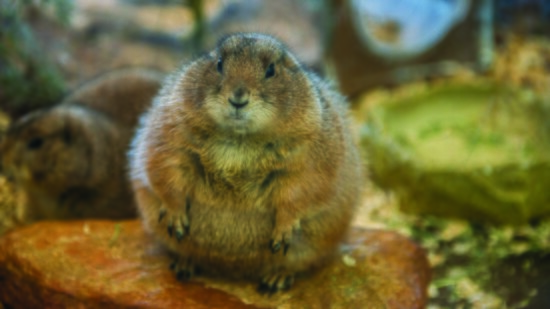Have you ever seen an opossum cross your backyard, a crow cawing on the fence post, or an eagle soaring overhead? Wildlife abounds in the city, and the Prairie Park Nature Preserve is the perfect place to learn more about the creatures and fauna living around us.
Prairie Park is a 100-acre nature preserve on the east side of Lawrence. The area includes wetlands, woodlands, prairie habitats, and a seven-acre lake. The Nature Center, established in 1999, is a place where kids and adults can learn about the local environment through live native animal exhibits, habitat dioramas, and educational displays.
Nature Center supervisor Dara Wilson is often found holding Phoebe, trained to be around people. The furry, sweet animal behaves more like a family cat than a wild animal.
"A lot of people think it's a scary animal when they see one in the backyard," Wilson says. "And then they come here and meet our opossum, which we call an ambassador animal because she's like the representative of her species. It makes it less scary when they do come across one. They're not afraid, especially when we tell them they rarely ever have rabies and eat a lot of ticks. Their defense mechanism is to play dead, so they won't lunge at them."
Visitors can stroll through the exhibits to learn more about our native wildlife. Sometimes, they wonder if the animal they're looking at is a display or alive, watching until they see the still turtle breathing or the skink move under a rock. Prairie dog sisters Pip and Squeak spend time eating breakfast in their enclosure while snakes snooze in their cages.
A black crow caws a greeting. He was raised by humans and cannot be released into the wild. The same goes for the vulture housed outside the center's back doors. A great horned owl named Sova, a barn owl, and golden and bald eagles also live there. They were injured and can no longer survive in the wild.
The center also houses animals not native to Kansas but needing a home. A scarlet macaw named Ms. Tino arrived in the early 2000s when a KU student left her behind, and Gandalf, an African grey parrot, came after his owner died. There is also a large python brought there by animal control when there was nowhere else for him to go.
Wilson points out, "It's all free to the public. There are a lot of interactive displays in the building. A new one we just added as the bison button. Do you know what a bison sounds like? If you push that button, you'll hear it sounds a bit like a dinosaur. So there's interactive science just for kids and adults to learn about the animals you could find in Kansas or who used to live in Kansas."
Outside the center, the park features a one-and-a-half-mile paved trail and numerous hiking trails through the various ecosystems. Mary's Lake is stocked twice yearly with native fish such as big-mouth bass, blue gill, crappie, and catfish. The Douglas County Heritage Conservation Council recently granted $71,000 to support improvements throughout the park. Upcoming projects include signage updates, construction of a 360-square-foot fishing/wildlife observation dock, ecological restoration along the lake's shoreline, and interactive educational opportunities for students and visitors.
Special programs are offered for both kids and adults. Some more popular ones include turtle yoga, wild nocturnal hikes, archery, and canoeing. The kids enjoy breakfast for dinner with the animals while teens and adults have fun with Animal House Game Night, where they stick their hands inside a box and guess what's inside. (Is it a living creature, a furry animal, or a slimy cucumber?)
"We're all aware there are environmental issues that are happening," Wilson says. "The tall grass prairie is the most endangered ecosystem in North America. And plants aren't the easiest thing for a kid to connect with. But if you use a great animal like our redtail hawk to talk about the importance of the prairie for its survival and how it all relates, it helps them connect with why this is important and why we need to conserve our natural spaces for future generations."
To learn more about Prairie Park Nature Center and see a park map, go to LawrenceKS.org/LPRD/PPNC.
"...it helps connect with why this is important and why we need to conserve our natural spaces for future generations."
